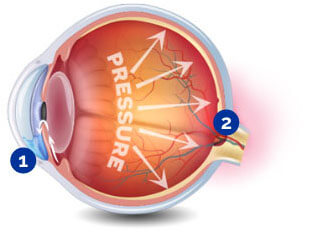
What is glaucoma?
Glaucoma is often caused by a build-up of pressure within the eye. This excess pressure can damage the optic nerve at the point where it leaves the eye to carry visual information to the brain. It can lead to vision loss and cause blindness, which is irreversible.1,2
Normal eye

Glaucoma

-
Drainage canal blocked
Too much fluid stays in the eye. This increases pressure -
High pressure damages optic nerve
Our brains can – cleverly – fill in areas of missing vision, so many people do not realise their eyesight is getting worse.1 Because of this, glaucoma is sometimes called the ‘silent blinding disease’.2 There are several types of glaucoma such as ‘primary open angle’, ‘closed’ and ‘normal tension’.3
Primary open angle glaucoma commonly has few symptoms in the early stages of the disease.2
References
- Hoste AM. Bull Soc Belge Ophtalmol 2003;287:65-71
- Weinreb RN et al. JAMA 2014;311(18):1901-11
- Glaucoma Research Foundation. Types of glaucoma. Available at: https://www.glaucoma.org/glaucoma/types-of-glaucoma.php Last accessed May 2019


